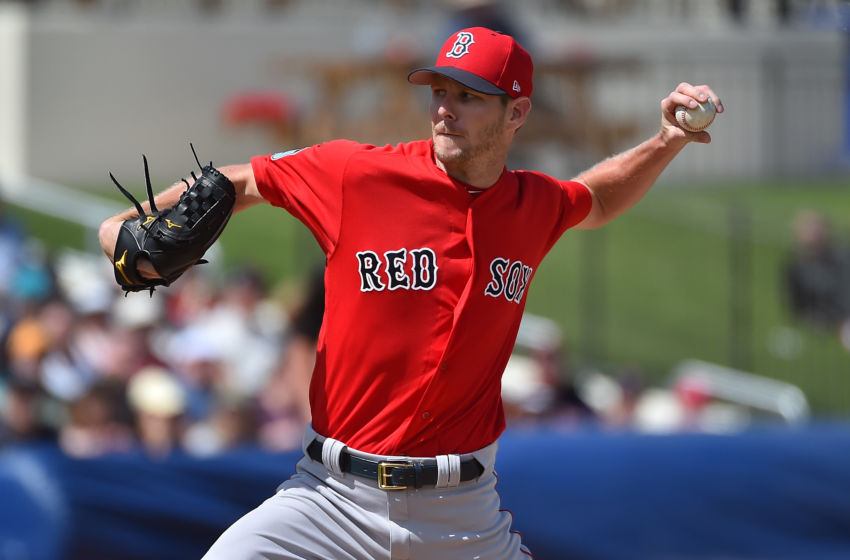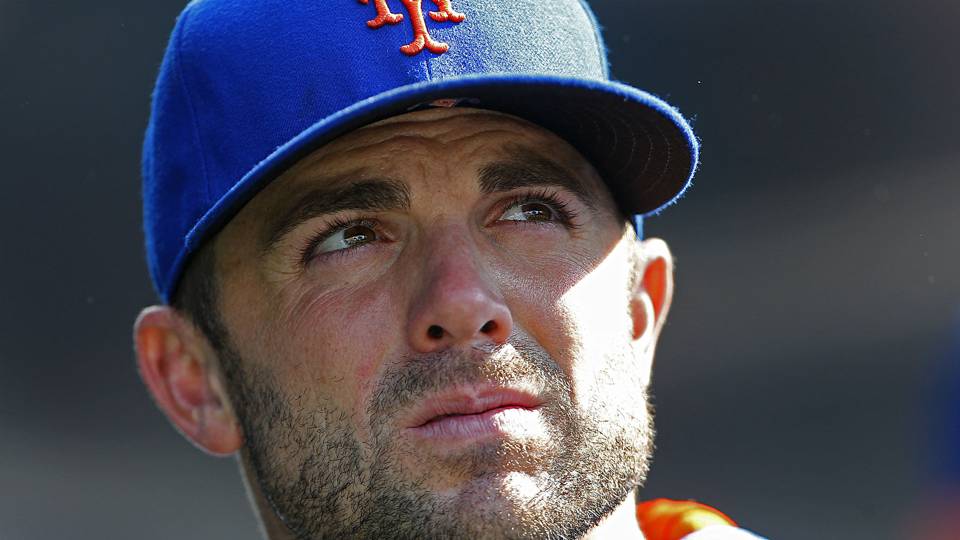 |
| Sale was solid in Monday's Spring Training debut (Chowder and Champions) |
It's been a little more than three months since the Red Sox rocked the sports world by
trading for Chris Sale, and I'm still having trouble eating solid food. That's because my jaw is still unhinged from when I first heard the news of baseball's biggest offseason maneuver, a stunning blockbuster that altered the courses of both franchises for years to come. Four months after
courting Sale at the trade deadline, Boston finally got its man -- at an exorbitant price.
Only now is it starting to sink in. Sale made his first appearance with his new team in Spring Training this week, and it went reasonably well. He didn't dominate, but he "
felt strong," which is all anyone cares about this time of year. The rust will dissipate, the command will come.
Of course, any other news would have been worrisome. It was Sale's first start -- he
should feel strong. But with the aftershocks from
last week's David Price scare still reverberating throughout New England, a positive update on his co-ace was highly encouraging for Red Sox Nation. At least one of Boston's elite arms is healthy.
Most teams don't even have a pitcher like Price to begin with, and the ones that do could hardly afford to lose him. The Red Sox can, however, because they are in a unique position. They have a younger, better version of Price in Sale -- a poor man's
Clayton Kershaw. If the whitecoats pronounced Price out for the season tomorrow, Boston could still be reasonably expected to win 90 games and the AL East. That speaks to how good the rest of their roster is, as well as Sale's ability to carry a staff.
That's what the Red Sox envisioned when they mortgaged their future for him. Boston failed to land Sale at the deadline, settling for
Drew Pomeranz instead, but upped the ante when Chicago made him available again during baseball's winter meetings. Once Dave Dombrowski fixates on a player, he'll do whatever it takes to acquire him, whether that's shell out over $200 million for
Prince Fielder (and Price) or strip his franchise of its most coveted prospects.
Given that Boston already runs one of the highest payrolls in professional sports, Dombrowski's resorted to cannibalizing its once-bright farm system in a series of trades for Pomeranz,
Craig Kimbrel,
Tyler Thornburg, and now Sale. No team had ever traded the number one prospect before, until Dealin' Dave flipped
Yoan Moncada to the White Sox along with
Michael Kopech -- a flamethrower who's been
clocked at 105 -- and a pair of decent throw-ins (
Victor Diaz and
Luis Alexander Basabe, both of whom have big league potential). Boston boasted the sport's
best farm system when Dombrowski took over in August, 2015. Eighteen months later, they have
one of the worst.
The transformation at the Major League level has been equally swift, however, as Dombrowski's wheeling and dealing paid immediate dividends. A last place team when Dombrowski arrived on the scene, the Red Sox won the division in their first full year under his watch and enter 2017 as
favorites to make the World Series. Not since 2011 have the Sox been so star-studded.
Their loaded roster is a byproduct of Dombrowski's eternal commitment to winning now, future be damned. Whereas his predecessor, Ben Cherington, was a conservative prospect-hugger who preferred to open his checkbook for players he wanted, Dombrowski never met a prospect he wouldn't trade (not even
Andrew Benintendi, baseball's new number one prospect and already a fan favorite,
was safe). Their wildly different approaches manifested in the players they pursued; Cherington sought mid-tier, impact veterans such as
Shane Victorino,
Hanley Ramirez, and
Pablo Sandoval, whereas Dombrowski reaches for the stars. Cherington didn't acquire a true superstar during his four years at the helm, while Dombrowski has already acquired two future Hall of Fame starters and the
decade's best closer in half the time. Cherington's 2015 club
didn't have an ace; Dombrowski obtained two in the span of 12 months.
There's a new sheriff in town, and a trigger-happy gunslinger at that.
 |
| Price has struggled with his health and performance in Boston (CBS Boston) |
It was this sweeping shift in philosophy that made the Sale swap possible, because Cherington never would have had the stomach for it. To get a lot you need to give a lot in return, and Dombrowski was willing to pony up. Boston got another ace to pair with Price, giving them their best 1-2 pitching punch since
Curt Schilling joined
Pedro Martinez in 2004. Chicago netted a budding superstar and a potential ace in return,
accelerating its rebuild with what Dave Cameron hailed as the winter's
best transaction.
Indeed, the future is bright for both sides. The Red Sox are the
prohibitive favorites in the AL East and a top-five team despite losing
David Ortiz --
the best hitter in baseball last year -- to retirement. The White Sox now have the foundation for a winning team and should emerge as contenders by decade's end. On paper, the trade was a classic win-win.
And yet, I was admittedly lukewarm about the Sale acquisition when it was announced back in December. I felt then, and still feel now, that Boston overpaid for Sale's services. They gave up six years of Moncada for three years of Sale, plus whatever Kopech and co. provide (which could be substantial, given how hard Kopech and Diaz throw and the tools Basabe displayed as a teenager). If Moncada and Kopech realize their potential, this trade is a clear win for Chicago. If all four do, it will be disgustingly lopsided.
What bothered me most about the trade, however, was that the Red Sox didn't
need Sale. They already had an ace and one of the best rotations in baseball, finishing top-10 in
ERA and
fWAR last year. Their stable featured two
Cy Young winners (Price and
Rick Porcello) at the top, two 2016 All-Stars (
Steven Wright and Drew Pomeranz), and a likely future All-Star in
Eduardo Rodriguez. They still had
Clay Buchholz at the time too, another former All-Star and occasional Cy Young contender when healthy, but quickly
dumped him on Philadelphia after Sale made him expendable.
For all of Buchholz's struggles last year, he was a meaningful contributor in a variety of roles and was a dominant starter as recently as 2015. He still provided value last year despite posting the
second-worst ERA (4.78) and highest FIP (5.06) of his career, and almost certainly would have pitched better this year, especially if used exclusively in relief. He could have given this year's outfit
something if not depth, but obviously Dombrowski felt differently. Gaining Sale meant losing Buchholz along with the aforementioned prospects -- too much, in my estimation.
And so I did not feel the ecstasy that baseball fans are supposed to feel when their team scores an ace, the way I felt when the Sox got Schilling and
Josh Beckett and
Daisuke Matsuzaka. Too much had been sacrificed to fill a void that did not exist, to make an already great team marginally better. It did nothing to address the gaping hole in the middle of Boston's lineup, which most agreed was the team's most pressing issue entering the offseason and one that could have been readily filled by any number of inexpensive right-handed sluggers (
Mike Napoli,
Chris Carter,
Mark Trumbo, et. all) who would have fit perfectly in Fenway. If Dombrowski wanted to make a splash, he could have wooed
Edwin Encarnacion or
Jose Bautista a moderate sum. Instead, he paid a king's ransom for Sale and signed
Mitch Moreland to man first.
Circumstances have changed since December, however, and now Sale appears even more valuable. With Price's 31-year-old elbow in question and his future uncertain, it's comforting to know that Boston still has someone to lead the rotation. Were it not for Sale that would have been Porcello, who's had one great year in his eight-year career and is more of a number two at best. The pressure on him would have been enormous, and we all remember how well (or rather, how poorly) he performed the last time he faced sustained pressure after
signing his huge contract extension early in 2015. His postseason numbers (0-3, 5.66 ERA) tell a similar story.
Sale has never pitched in October, but he has fronted a staff for the past half-decade. All he's done during that time is make five straight All-Star teams and finish in the top six of Cy Young voting every year. Last year he focused on pitching
deeper into games and recorded a career-high 226 2/3 innings -- just 10 outs shy of Price's ML-leading 230 -- and won 17 games for a losing team. He could easily win 20 on the Sox and
possibly the Cy which has eluded him. Sale can be counted on for over 200 quality innings, a similar number of strikeouts and an ERA around three -- the same steady production for which Boston made Price the
highest-paid pitcher in history. If both stay healthy, the Red Sox should have one of the best rotations in baseball and will be difficult to beat come playoff time.
Dombrowski drew a fair amount of criticism for going all-in on Sale. After investing nearly a quarter-billion dollars in Price the previous winter, it was hard for him to justify doubling down on another ace. Sale was a
luxury Boston didn't need. But when you splurge on a sports car the warranty becomes an afterthought, and whether they knew it or not the Red Sox were essentially getting an insurance policy on Price in Sale. And like all insurance policies, you never truly appreciate it until you need it.


